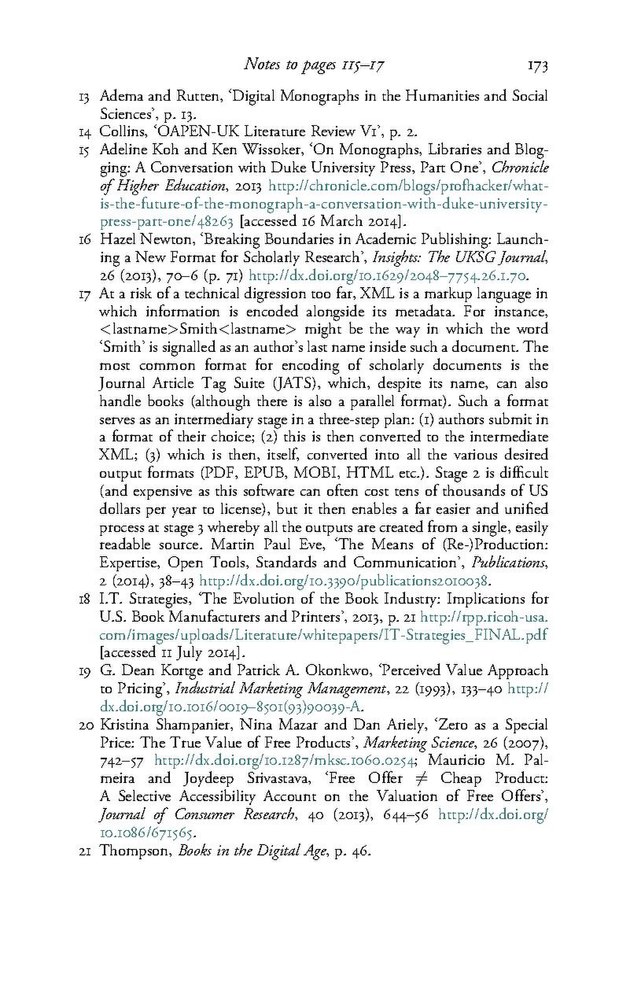13 Adema and Rutten, ‘Digital Monographs in the Humanities and Social Sciences’, p. 13.
14 Collins, ‘OAPEN-UK Literature Review V1’, p. 2.
15 Adeline Koh and Ken Wissoker, ‘On Monographs, Libraries and Blogging: A Conversation with Duke University Press, Part One’, Chronicle of Higher Education, 2013 http://chronicle.com/blogs/profhacker/what-is-the-future-of-the-monograph-a-conversation-with-duke-university-press-part-one/48263 [accessed 16 March 2014].
16 Hazel Newton, ‘Breaking Boundaries in Academic Publishing: Launching a New Format for Scholarly Research’, Insights: The UKSG Journal, 26 (2013), 70–6 (p. 71) http://dx.doi.org/10.1629/2048–7754.26.1.70.
17 At a risk of a technical digression too far, XML is a markup language in which information is encoded alongside its metadata. For instance <lastname>Smith<lastname> might be the way in which the word ‘Smith’ is signalled as an author’s last name inside such a document. The most common format for encoding of scholarly documents is the Journal Article Tag Suite (JATS), which, despite its name, can also handle books (although there is also a parallel format). Such a format serves as an intermediary stage in a three-step plan: (1) authors submit in a format of their choice; (2) this is then converted to the intermediate XML; (3) which is then, itself, converted into all the various desired output formats (PDF, EPUB, MOBI, HTML etc.). Stage 2 is difficult (and expensive as this software can often cost tens of thousands of US dollars per year to license), but it then enables a far easier and unified process at stage 3 whereby all the outputs are created from a single, easily readable source. Martin Paul Eve, ‘The Means of (Re-)Production: Expertise, Open Tools, Standards and Communication’, Publications, 2 (2014), 38–43 http://dx.doi.org/10.3390/publications2010038.
18 I.T. Strategies, ‘The Evolution of the Book Industry: Implications for U.S. Book Manufacturers and Printers’, 2013, p. 21 http://rpp.ricoh-usa.com/images/uploads/Literature/whitepapers/IT-Strategies_FINAL.pdf [accessed 11 July 2014].
19 G. Dean Kortge and Patrick A. Okonkwo, ‘Perceived Value Approach to Pricing’, Industrial Marketing Management, 22 (1993), 133–40 http://dx.doi.org/10.1016/0019–8501(93)90039-A.
20 Kristina Shampanier, Nina Mazar and Dan Ariely, ‘Zero as a Special Price: The True Value of Free Products’, Marketing Science, 26 (2007), 742–57 http://dx.doi.org/10.1287/mksc.1060.0254; Mauricio M. Palmeira and Joydeep Srivastava, ‘Free Offer ≠ Cheap Product: A Selective Accessibility Account on the Valuation of Free Offers’, Journal of Consumer Research, 40 (2013), 644–56 http://dx.doi.org/10.1086/671565.
21 Thompson, Books in the Digital Age, p. 46.
